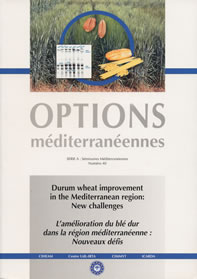| Article précédent | p. 141-144 | Article suivant |
Near infrared reflectance spectroscopy as a new screening tool to increase durum wheat yield
Near Infrared Reflectance Spectroscopy (NIRS) is widely used in routine screening as it provides a quick, non-destructive assay requiring little or no sample pretreatment. Here, we present a new application of NIRS as an indirect selection tool during the early generations of a breeding program addressed to increase durum wheat yield under Mediterranean conditions. To assess the ability of NIRS in yield evaluation, spectral reflectance was measured in kernels from a large set of genotypes, cultivated in three different environments in NW-Syria, providing a wide range of yield (from about 600 to 9500 kg per ha). Partial Least Squares Regression (PLSR) was used to model the association between grain yield (GY) and these spectra, and strong significant correlations (P less than 0.001) were found between NIRS-predicted and measured yield, with r2 values of 0.88 and 0.76 for calibration and prediction sets, respectively.
- [ Afficher ]
- [ Télécharger ]
- [ Exporter la citation ]
Vous pouvez télécharger la citation au format :
- [ Imprimer ]
-
Mots-clés
BLE DUR, CROISSANCE, GRAIN, POIDS, RENDEMENTCiter cet article
Ferrio J.P., Araus J.L., Bertran E., Nachit M., Royo C. Near infrared reflectance spectroscopy as a new screening tool to increase durum wheat yield. In : Royo C. (ed.), Nachit M. (ed.), Di Fonzo N. (ed.), Araus J.L. (ed.). Durum wheat improvement in the Mediterranean region: New challenges . Zaragoza : CIHEAM, 2000. p. 141-144. (Options Méditerranéennes : Série A. Séminaires Méditerranéens; n. 40). Seminar on Durum Wheat Improvement in the Mediterranean Region: New Challenges, 2000/04/12-14, Zaragoza (Spain). http://om.ciheam.org/om/pdf/a40/00600019.pdf



